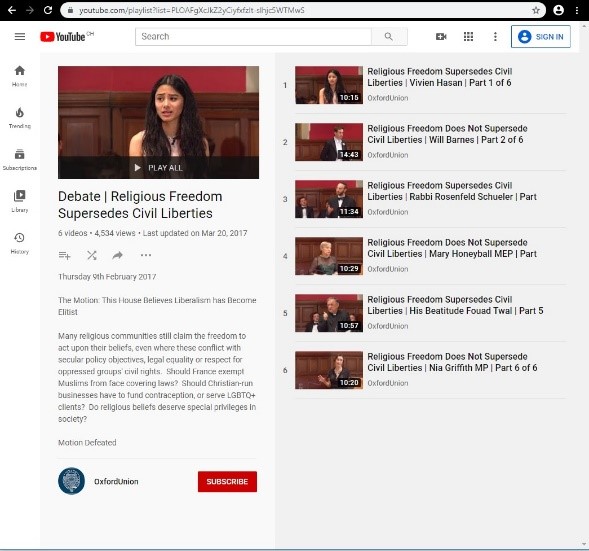Module 8: Continuous review
#Faith4Rights toolkit
Full text of commitment VIII
|
We therefore pledge to establish, each within our respective spheres, policies and methodologies to monitor interpretations, determinations or other religious views that manifestly conflict with universal human rights norms and standards, regardless of whether they are pronounced by formal institutions or by self-appointed individuals. We intend to assume this responsibility in a disciplined objective manner only within our own respective areas of competence in an introspective manner, without judging the faith or beliefs of others. - “Do not judge, or you too will be judged. For in the same way you judge others, you will be judged, and with the measure you use, it will be measured to you.” (Bible, Matthew 7:1-2) - “Habituate your heart to mercy for the subjects and to affection and kindness for them… since they are of two kinds, either your brother in religion or one like you in creation… So, extend to them your forgiveness and pardon, in the same way as you would like Allah to extend His forgiveness and pardon to you” (Letter from Caliph Ali to Malik Ashtar, Governor of Egypt)
- “The essential purpose of the religion of God is to establish unity among mankind. The divine Manifestations were Founders of the means of fellowship and love. They did not come to create discord, strife and hatred in the world. The religion of God is the cause of love, but if it is made to be the source of enmity and bloodshed, surely its absence is preferable to its existence; for then it becomes satanic, detrimental and an obstacle to the human world.”(‘Abdu’l-Baha) |
Context
Religious views and determinations are expressed in many ways from various sources, often with little accountability. Unlike most professions, that of religious leader does not have an explicit code of deontology.
The questions of criteria of authoritativeness and hierarchy among sources of religious views are complex Cyberspace complicates matters and facilitates incitement to discrimination or violence. Formal religious institutions are well established but they are no longer the only actors in the religious sphere. A dangerous mixture of ignorance, manipulation and confusion in the area of religious determinations divides communities and produces statements that deepen the rift between faith and rights. Religious institutions and faith actors themselves are best placed to redress this situation through observation, analysis and self-monitoring of religious discourse. Religious teaching curricula are an important context to practice self-monitoring and refinement as faith actors deem it necessary. Developing and updating religious curricula can be a lengthy process. Such an important role requires a dedicated research capacity and an investment in interdisciplinary knowledge.
Additional supporting documents
In support of module 8, the learning file should include the Plan of Action for Religious Leaders and Actors to Prevent Incitement to Violence that Could Lead to Atrocity Crimes (2017), which calls on religious leaders and actors to: “Monitor the media, including social media, to ensure that hate speech that could constitute incitement to violence is constantly identified and countered; Disseminate positive images and stories about faiths other than one’s own; Speak out not only when one’s own community is targeted but also when a religious community different from one’s own is targeted; Support the initiatives of other religious leaders and actors who speak out in support of human rights and justice and of oppressed communities, in particular; Monitor, compile and circulate religious statements and decrees issued by religious leaders and authorities that incite to hatred and violence; Issue and circulate reports of religious statements and decrees by religious leaders and authorities denouncing incitement and/or offering alternative messages”.
United Nations Secretary-General António Guterres has stressed: “Around the world, we are seeing a disturbing groundswell of xenophobia, racism and intolerance – including rising anti-Semitism, anti-Muslim hatred and persecution of Christians.” The UN Strategy and Plan of Action on Hate Speech (2019) includes the following key commitment: “Relevant UN entities should be able to recognize, monitor, collect data and analyze hate speech trends.” It also notes that “There is no international legal definition of hate speech, and the characterization of what is ‘hateful’ is controversial and disputed. In the context of this document, the term hate speech is understood as any kind of communication in speech, writing or behavior, that attacks or uses pejorative or discriminatory language with reference to a person or a group on the basis of who they are, based on their religion, ethnicity, nationality, race, color, descent, gender or other forms of identity.”
In addition, the UN Plan of Action to Safeguard Religious Sites (2019) recommends that religious leaders “Proactively and regularly engage in interfaith dialogue, including the promotion of solidarity and resilience. […] Discuss issues of contemporary relevance with the congregation and educate them on other religions and cultural diversity to promote interreligious dialogue, understanding, mutual respect and peace. Stay engaged and be vocal and active when religious sites and worshippers from other religions and faiths are targeted. Actively and proactively engage on social media to reach out to a variety of users. Develop media content, including through the creation or strengthening of websites to make religious texts and messages accessible to a wider audience and provide answer to challenges related to social exclusion, annihilation, and hatred. Use their influence to persuade those with whom they hold influence to avoid inflammatory speech.”
With regard to a vibrant and active civil society, the Special Rapporteur on human rights and counter-terrorism, Fionnuala Ní Aoláin, referred to the 2018 UN High-level Conference of Heads of Counter-Terrorism Agencies of Member States, where “the representative of Finland stated that civil society and religious communities played a significant role in preventing violent extremism and countering terrorism”.
Peer-to-peer learning exercises
Unpacking: Participants break down commitment VIII into different elements ( individual exercise for five minutes followed by ten minutes of a full group discussion on the differences between individual listings). Facilitators should find in commitment VIII a large space for implicit elements. In particular, a qualifier like “within our respective spheres” entails a certain degree of discipline designed to protect faith actors from being dragged into political manipulation. The same applies to the triple qualifier “in a disciplined objective manner only within our own respective areas of competence in an introspective manner, without judging the faith or beliefs of others”.
The latter is important to delimit freedom of expression within the theological discourse from a grey zone that may reach the threshold of advocacy to hatred that could constitute incitement to violence. While alerting participants to the fact that the demarcation line between these two is thin, facilitators should cross-refer at this conjuncture to commitment VII concerning “incitement to hatred” and particularly to the six-part threshold test outlined in the Rabat Plan of Action. Furthermore, the Human Rights Committee’s general comment No. 37 on the right of peaceful assembly (adopted in July 2020) includes in footnotes 19 and 60 specific references to the threshold test in the Rabat Plan of Action as well as to the Beirut Declaration and its 18 commitments on “Faith for Rights”. See also the related discussion at a Massive Open Online Course.
Linking the dots: The facilitator may discuss the relationship between these elements, with specific examples from the local environment of the participants. Important dots to link in this context include the role and voice of faith actors as an autonomous non-state actor and its importance to monitor religious interpretations that manifestly conflict with universal human rights norms and standards (collective exercise for 10-15 minutes).
Critical thinking: A critical discussion of the notions of “monitoring” and “self-monitoring“ would open useful and interesting avenues in terms of linking faith and rights. In both spheres, monitoring is central. However, this commitment raises some tough questions. Does this commitment establish a hierarchy of a “secular human rights discourse” over religions? Are human-made laws more binding than religious texts? Facilitators should bear in mind that these questions are the “elephant in the room” and that they could be divisive. Such sensitive questions need not be avoided; to the contrary, they should be brought to the forefront of the discussion as early as possible in a critical learning mode among faith actors. Facilitators should steer the discussion towards the conclusion that it is a false dichotomy to construe a hierarchy between faith and rights.
 Facilitators may familiarize themselves with related arguments, for example those presented in a series of six videos of a competitive debate at the Oxford Union. Depending on the available time and priorities of the learning exchange, facilitators may also show these videos.
Facilitators may familiarize themselves with related arguments, for example those presented in a series of six videos of a competitive debate at the Oxford Union. Depending on the available time and priorities of the learning exchange, facilitators may also show these videos.
Participants may also be asked if they agree with the possibility of monitoring religious interpretations. Are there legal or institutional limitations within their national context that organize or inhibit such monitoring? Does such a function exist within their religious spheres? In which form? Is it functioning well? Are there missing elements in this commitment?
Time needed and precautions to bear in mind: This collective exercise could take 30-40 minutes as it raises complex issues and may require a progressive approach to handling them. The main guidance is that the facilitator should anticipate tensions rather than trying to escape from them. Some of these questions can turn intensely ideological, but they still need to be addressed.
Disagreements are healthy, provided that divergent views are expressed respectfully and are discussed with a human rights-based approach. This includes freedom of expression, respect for diversity and equal opportunities to argue for different views. Facilitators should bear in mind that full agreement is not the only goal of a discussion. A better understanding of divergent views is often as precious as reaching a common position. The facilitator's setting of that tone serves an important purpose of the “Faith for Rights” collective learning. After all, faith actors should be able to convey in their everyday-work the humbling fact that there is no monopoly on truth and that respectful dialogue does not always need to end in agreement.
Storytelling: Participants share personal experiences pertaining to this commitment and how they handled them. In particular, has there been a situation where participants confronted obviously deviating religious interpretations? What was their reaction? In which areas in particular do such deviations occur in the participants’ surroundings? (Collective exercise for 15-20 minutes)
The facilitator could also refer to MONUSCO’s report on hate speech in the Democratic Republic of the Congo (March 2021), which analyses certain cases according to the position of the speaker, mode of dissemination, identity of target group and likelihood of harm. The recommendations to political and religious actors explicitly refer to the Rabat Plan of Action and Beirut Declaration, notably its commitments VI and VII.
Exploring: Are there experiences in self-monitoring in the religious sphere that participants know of?
What could be the functions of an observatory of religious rulings that violate human rights?
How to distinguish between a deviating religious ruling that violates human rights and the right to academic freedom of research and expression? What are the permissible limitations of religious autonomy? Time needed and precautions to bear in mind: This exercise covers complex and sensitive issues. It requires 30-40 minutes of orderly debate that is skilfully steered. Facilitators have to be knowledgeable on these tricky legal points. They should also be well prepared with compelling examples in this area, preferably drawn from case law of international human rights mechanisms (see jurisprudence of UN human rights Treaty Bodies, communications by Special Procedures and the Universal Human Rights Index facilitates access to recommendations also from the Universal Periodic Review). Indeed, a compilation of such views need to be prepared and regularly updated so that facilitators can fulfil their role safely and effectively.
Tweeting: Summarize commitment VIII within 140 characters (individual exercise for five minutes). One possible result of this tweeting exercise could be as follows: “We commit to monitor interpretations, determinations or other religious views that manifestly conflict with universal human rights norms and standards”.
Translating: Similar to the tweeting exercise, participants could be asked to “translate” this commitment into child-friendly language or into a local dialect. Again the idea is to stimulate discussion about the most important elements and appropriate ways of transposing and simplifying the message, without losing the substance of the commitment.
Adding faith quotes: This exercise consists in finding and adding new religious or belief quotes to commitment VIII (individual exercise for five minutes, followed by a reading from each participant of his added reference). For example, the following Rumi quotes stress the importance of introspectivity:“Your task is not to seek for love, but merely to seek and find all the barriers within yourself that you have built against it” and “Yesterday I was clever, so I wanted to change the world. Today I am wise, so I am changing myself.”

 Inspiring: Participants underline artistic expressions that capture aspects of commitment VIII. The facilitator could also make participants draw what “self-monitoring” means to them (for example: a person looking into a mirror).
Inspiring: Participants underline artistic expressions that capture aspects of commitment VIII. The facilitator could also make participants draw what “self-monitoring” means to them (for example: a person looking into a mirror).
In addition, please find here the example of a cartoon and calligraphy as well as music.
Learning objectives
- Critical thinking in introspective mode is an attitude that this module aims to strengthen among participants.
- Intellectual curiosity and interfaith literacy are enhanced through comparative knowledge about how different faith traditions face similar challenges and develop new approaches, including towards the management of religious diversity.
- Participants recognize that there should be no abstract hierarchy between faith and rights because their spheres are different, while their goals are common; their practice overlaps predominantly in mutual reinforcement while there may be tension zones that need to be resolved through interpretation and dialogue.
previous module ¦ overview ¦ next module >